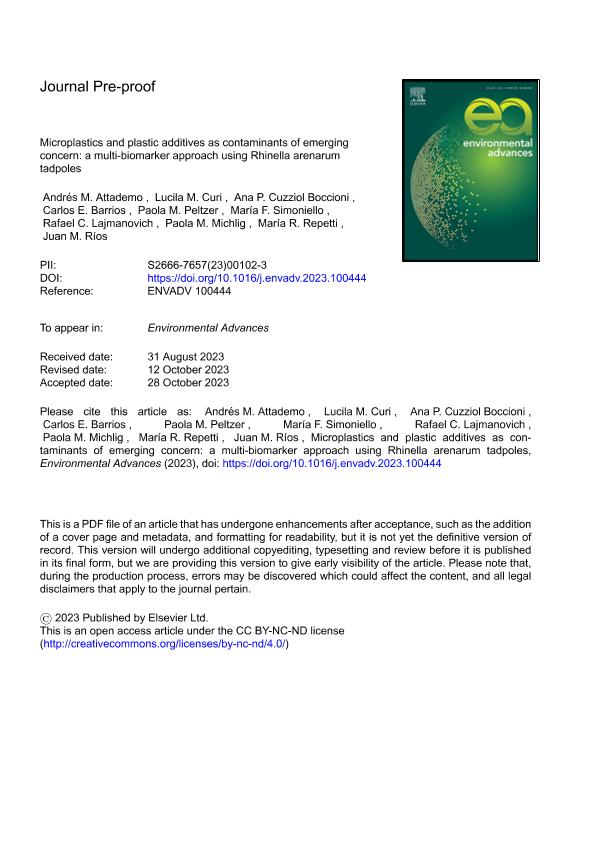Artículo
Microplastics and plastic additives as contaminants of emerging concern: A multi-biomarker approach using Rhinella arenarum tadpoles
Attademo, Andres Maximiliano ; Curi, Lucila Marilén
; Curi, Lucila Marilén ; Cuzziol Boccioni, Ana Paula
; Cuzziol Boccioni, Ana Paula ; Barrios, Carlos Eduardo
; Barrios, Carlos Eduardo ; Peltzer, Paola
; Peltzer, Paola ; Simoniello, María F.; Lajmanovich, Rafael Carlos
; Simoniello, María F.; Lajmanovich, Rafael Carlos ; Michlig, Melina Paola
; Michlig, Melina Paola ; Repetti, María Rosa; Rios, Juan Manuel
; Repetti, María Rosa; Rios, Juan Manuel
 ; Curi, Lucila Marilén
; Curi, Lucila Marilén ; Cuzziol Boccioni, Ana Paula
; Cuzziol Boccioni, Ana Paula ; Barrios, Carlos Eduardo
; Barrios, Carlos Eduardo ; Peltzer, Paola
; Peltzer, Paola ; Simoniello, María F.; Lajmanovich, Rafael Carlos
; Simoniello, María F.; Lajmanovich, Rafael Carlos ; Michlig, Melina Paola
; Michlig, Melina Paola ; Repetti, María Rosa; Rios, Juan Manuel
; Repetti, María Rosa; Rios, Juan Manuel
Fecha de publicación:
12/2023
Editorial:
Elsevier
Revista:
Environmental Advances
ISSN:
2666-7657
Idioma:
Inglés
Tipo de recurso:
Artículo publicado
Clasificación temática:
Resumen
Polyethylene microplastics (PE-MPs), a whitish thermoplastic polymer with numerous applications, is one of the materials most widely used in the industrial sector, whereas tetrabromobisphenol A (TBBPA) is a brominated flame retardant. The aim of this study was to analyze the effects of PE-MPs and TBBPA on Rhinella arenarum tadpoles at the laboratory scale. Tadpoles were chronically exposed (30 days) to four treatments: PE-MPs (60 mg L−1), TBBPA (10 µg L−1), their mixture (PE-MPs + TBBPA), and dechlorinated water as negative control (CO). Biomarkers of enzymatic activity (acetylcholinesterase, AChE; carboxylesterase, CbE; glutathione reductase, GR; and glutathione-S-transferase, GST), hepatic physiological alteration (alkaline phosphatase; ALP activity, and cholesterol; CHOL level), and endocrine disruption through thyroid hormone (T4) levels were assessed. In addition, intestine and liver were histomorphologically evaluated. AChE activity in tadpoles was significantly inhibited after exposure to PE-MPs and TBBPA with respect to CO. In addition, CbE, GR, and ALP activities showed higher values in the mixture of PE-MPs+ TBBPA treatment than in CO, whereas CHOL level was higher in TBBPA and PE-MPs+ TBBPA treatments than in CO. GST activity did not show significant differences between treatments and CO. T4 levels increased significantly in all treatments with respect to CO. The intestinal structure of tadpoles exposed to PE-MPs and PE-MPs+ TBBPA showed signs of mechanical damage. The intestinal wall of tadpoles under PE-MPs, TBBPA and PE-MPs+ TBBPA treatments was thicker than that of CO individuals. The analysis of liver histology demonstrated the hepatotoxicity caused by PE-MPs+ TBBPA. This study provides quantitative evidence of the harmful effects of PE-MPs, TBBPA and their mixture on enzymatic and hormonal activities, and histological evidence of intestinal wall hypertrophy and liver damage of R. arenarum tadpoles.
Palabras clave:
ANURAN TADPOLES
,
BIOMARKERS
,
POLYETHYLENE MICROPLASTICS
,
TBBPA
Archivos asociados
Licencia
Identificadores
Colecciones
Articulos(CCT - NORDESTE)
Articulos de CTRO.CIENTIFICO TECNOL.CONICET - NORDESTE
Articulos de CTRO.CIENTIFICO TECNOL.CONICET - NORDESTE
Articulos(CCT - SANTA FE)
Articulos de CTRO.CIENTIFICO TECNOL.CONICET - SANTA FE
Articulos de CTRO.CIENTIFICO TECNOL.CONICET - SANTA FE
Articulos(IMAM)
Articulos de INST.DE MATERIALES DE MISIONES
Articulos de INST.DE MATERIALES DE MISIONES
Articulos(IMBECU)
Articulos de INST. DE MEDICINA Y BIO. EXP. DE CUYO
Articulos de INST. DE MEDICINA Y BIO. EXP. DE CUYO
Citación
Attademo, Andres Maximiliano; Curi, Lucila Marilén; Cuzziol Boccioni, Ana Paula; Barrios, Carlos Eduardo; Peltzer, Paola; et al.; Microplastics and plastic additives as contaminants of emerging concern: A multi-biomarker approach using Rhinella arenarum tadpoles; Elsevier; Environmental Advances; 14; 12-2023; 1-43
Compartir
Altmétricas



